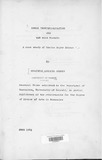| dc.contributor.author | Mwandihi, Lihanda A | |
| dc.date.accessioned | 2013-04-18T06:23:36Z | |
| dc.date.issued | 1985 | |
| dc.identifier.citation | M.A (Economics) Thesis 1985 | en |
| dc.identifier.uri | http://erepository.uonbi.ac.ke:8080/xmlui/handle/123456789/16317 | |
| dc.description | Master of Arts Thesis | en |
| dc.description.abstract | Cash crop production may be supported on the grounds that it enables participating"farmers to
earn incomes in excess of what subsistence production provided. Furthermore, cash crop activity offers direct and indirect employment to thousands of people. By producing domestically whatever was previously imported, the government saves foreign exchange which" is channe1led into welfare-improving activities. However" cash crop production has several repercussions. The introduction of cash crop activity in Mumias has meant stiff competition between sugarcane and food crops for limited land, labour, capital and financial resources. A proportionately large share of
total landholding is devoted to sugarcane production while food crops and livestock are robbed of land.
Reduced output of food crops has meant an increased dependence of farmers on the local markets
t:orfood supplies, most of which originate from Bungoma district and other locations within Kakamega
district. However, such food supplies might not be forthcoming since these locations have also been
"invaded by sugarcane. The situation is compounded. | en |
| dc.description.sponsorship | University of Nairobi | en |
| dc.language.iso | en | en |
| dc.title | Rural Industrialization and the Food Problem: a Case Study of Mumias Scheme | en |
| dc.type | Thesis | en |
| local.publisher | Depatment of Economics, University of Nairobi | en |

